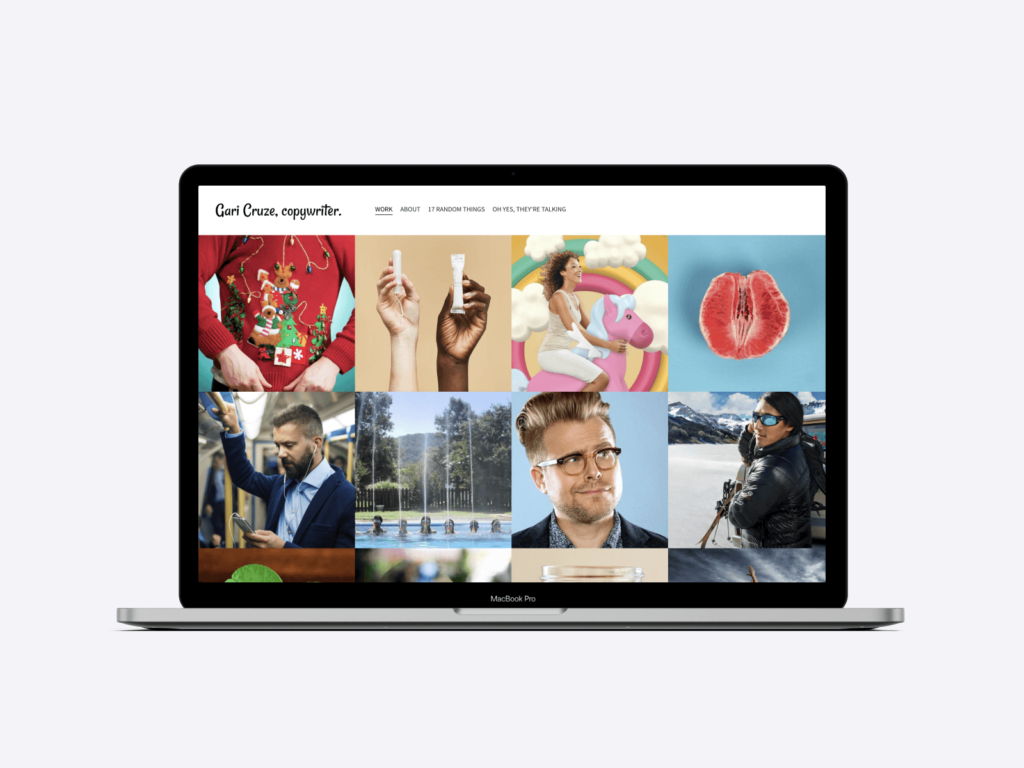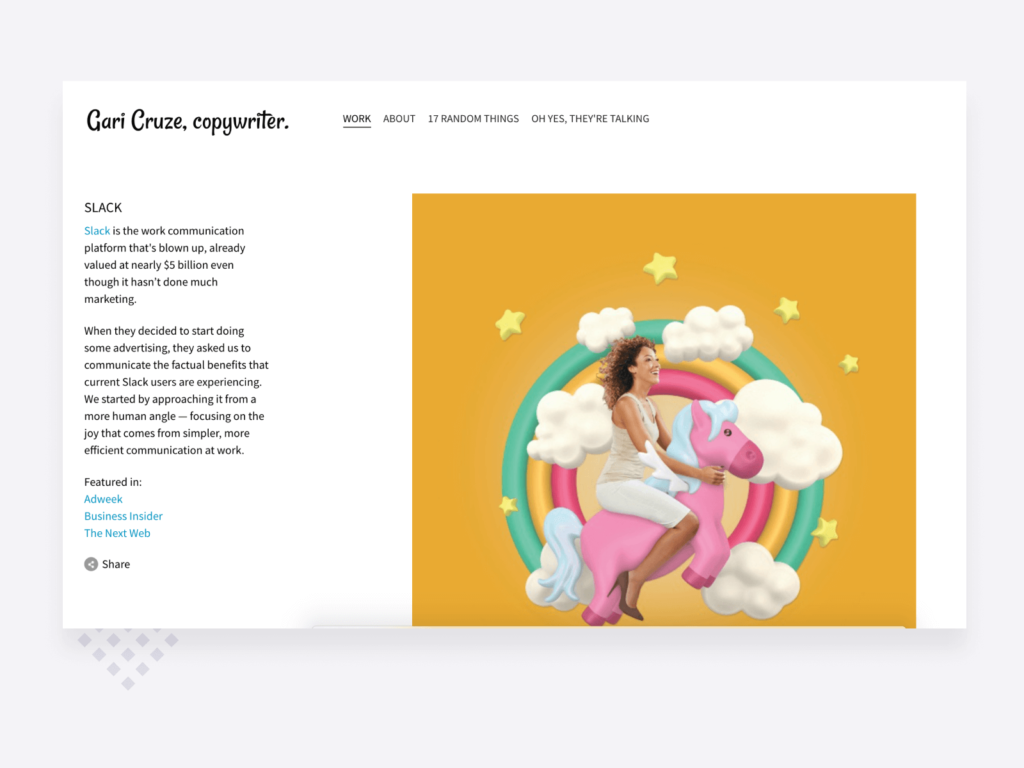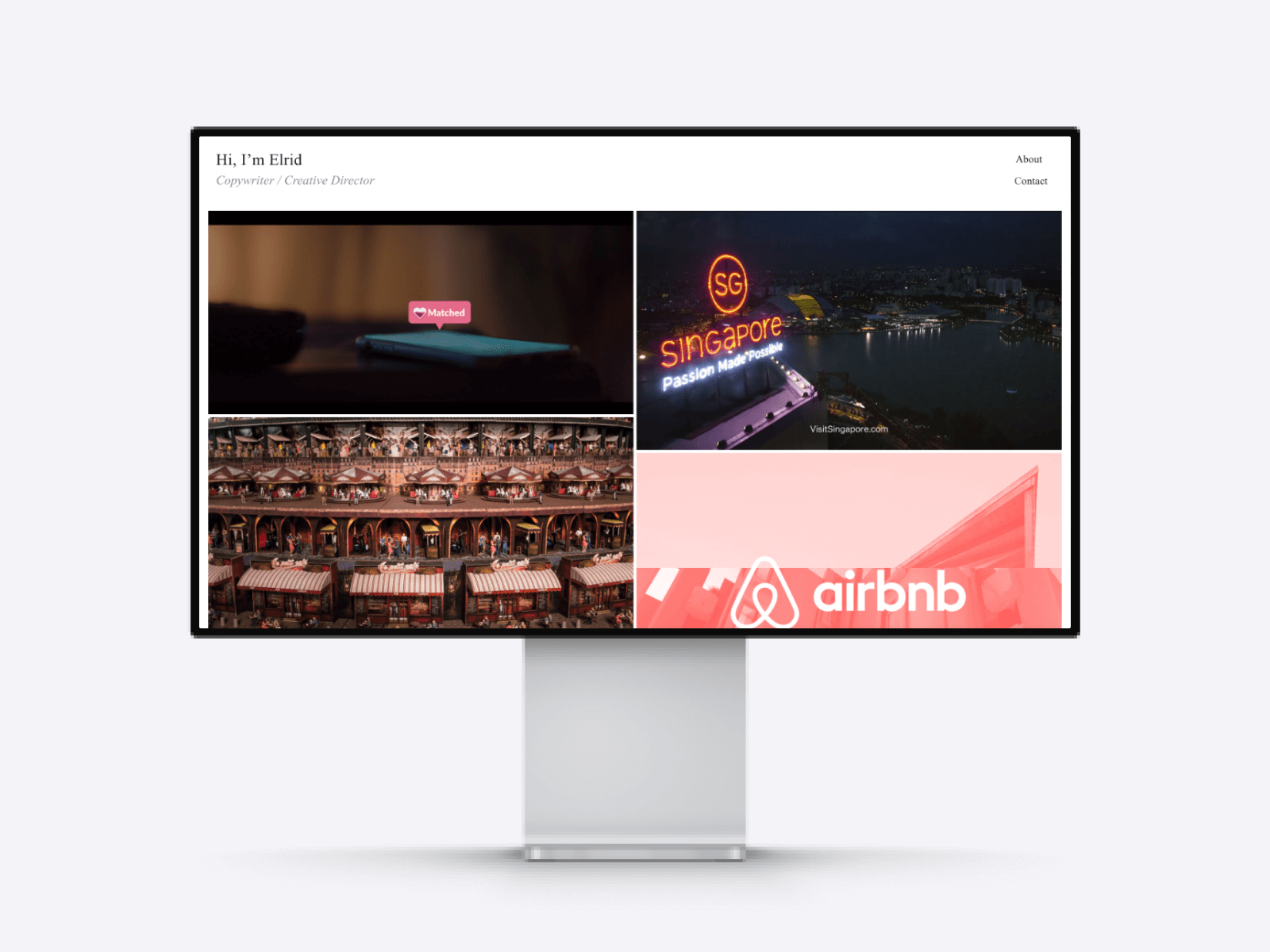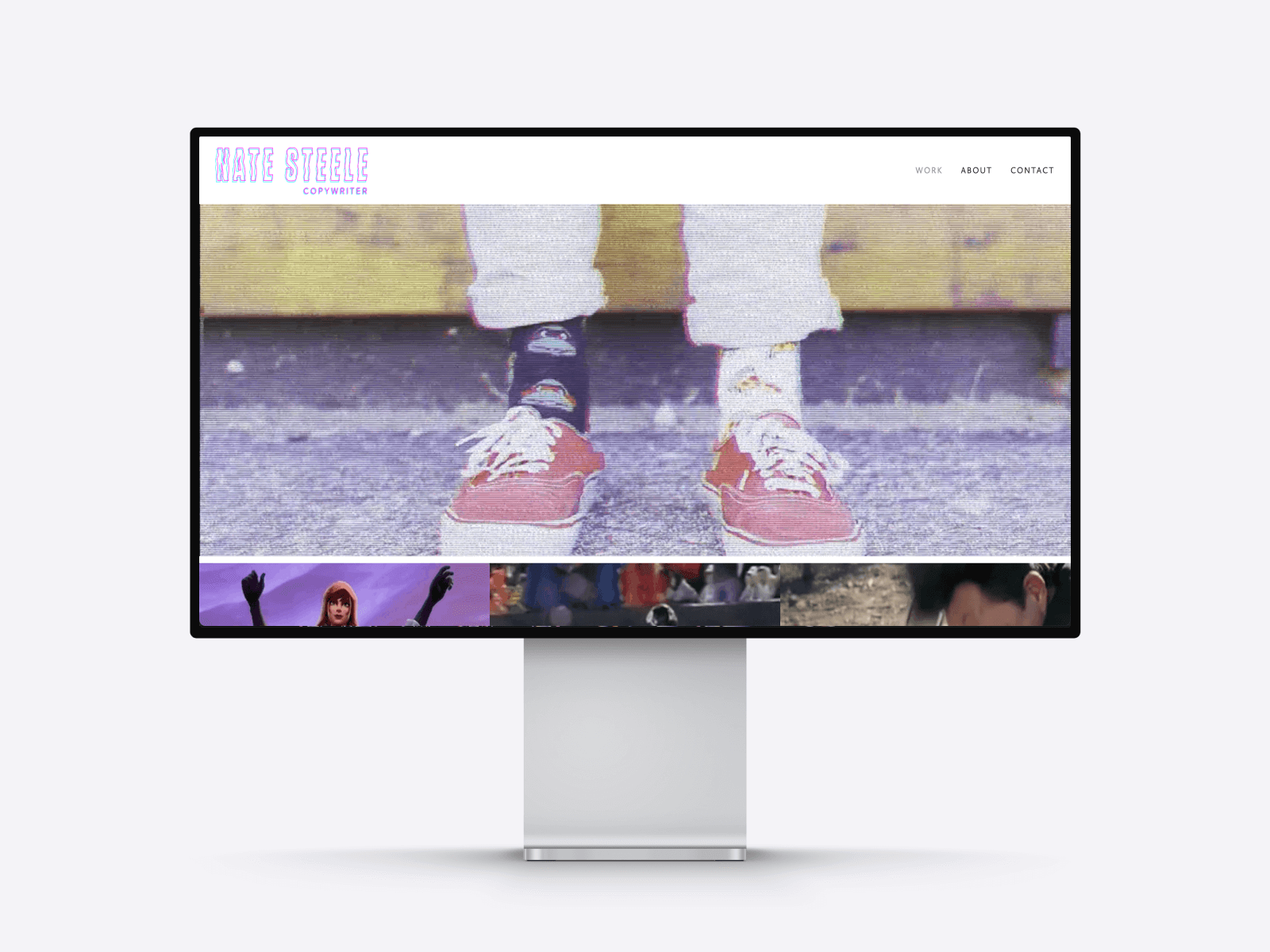Gari Cruze on What Creative Directors Are Looking For in a Copywriter Portfolio
Mesmerized by the commercials on TV as a child, Gari Cruze has always known he wanted to work in advertising. Combining that with his love for words, copywriting was a natural fit. With more than 15 years of experience in agency copywriting, Gari has worked with brands like Google, Slack, Lyft and even the United Nations and the US government. Now he’s an associate creative director and copywriter at the advertising and design agency, Huge.
Gari kindly sat down with us to talk about his career, favourite projects and creative process, and to discuss copywriting portfolios. As an ACD he gives insights into what creative directors are looking for when reviewing portfolios and what mistakes you should avoid when putting yours together. He even answers the age-old question of “how do I create a copywriting portfolio with no real experience?”.
Hi Gari, thank you for being on the blog! We’d like to ask a little bit about your career first. On your site, you write you always knew what you wanted to do. Can you tell us about how you made it happen?
Sure! When I was a kid, I always liked pop culture and TV. I liked the commercials I saw on TV, I was mesmerized by them. So advertising and copywriting got me interested, even when I was young.
I wasn’t positive if I wanted to be in advertising specifically, but I knew I wanted to write. Because I was always good at that, it just came naturally. Anything that had to do with words, I loved.
And later because of that love for words and language… when I was trying to figure out what to do for a living, it came to me: I could combine business and writing by being a copywriter. To me, it was a perfect marriage of a way to make a living, while also doing something that really interested me. Something that had some sort of an artistic element to it still.
What was your first job? How did you get started?
I didn’t go to ad school - I went to a small liberal arts college, and they didn’t even have an advertising degree. I ended up getting both a journalism degree and a PR degree with more of a concentration on marketing. I knew that would be a little bit of a disadvantage because a lot of people went to advertising school.
But I happened to live at home when I graduated from college, so I didn’t have any rent to pay. And that allowed me to go to an ad agency and say: I’ll work for you part-time for free if you’ll just let me come on. They said yes and gave me a try —and after a month they hired me full time.
Just being able to get in and prove myself as a writer, and that I was really dedicated to it, helped me get my first job at an agency. And from there I’ve been working at ad agencies ever since.
You have some really cool projects in your portfolio. Can you tell us about some of your favourites?
I worked with Lyft a couple of years ago —they wanted to do a Christmas activation, and we came up with the idea of doing ugly Christmas sweaters for cars. We got a woman specialized in yarn bombing, which is basically making giant sheets of crocheted yarn and customizing the shapes of them onto things. We hired one of them to do that for cars and they made giant sweaters for three different cars. It took weeks and it wasn’t cheap —but it ended up being Lyft’s most successful activation they’ve ever done.
https://vimeo.com/248087783
There was another project called Period Movement, it’s the second one in my creative director portfolio. It’s one of my favorite projects. It’s about period equality and the fact that especially in America, the tampon machines in women’s bathrooms are really old, broken half the time —or if they do work, they’re hardly ever stocked with tampons or pads. So we partnered with a group that is fighting to make tampons free, just like toilet paper is. It’s the same level of a human need, so why aren’t tampons free? They should be in public restrooms.
We worked with them to make a video and to start a conversation. We created a real toilet paper dispenser that took coins. In order to get toilet paper out of it, you had to have a quarter and feed it into the machine, so that it would open and you could actually get toilet paper out. We installed them in men’s restrooms. And we also made it so that if you didn’t have a quarter, you could tweet a message about period equality and that would activate it and open it up.
It was the only way to get it out. To either use a coin, which would frustrate men and drive that point home that women have to go through this and it’s ridiculous. Or they could tweet out a message saying “Tampons should be free, just like toilet paper is”. It was really just to get guys thinking about it and to support the movement.
https://vimeo.com/396299744
It got a ton of media coverage: it was in Glamour magazine, we had celebrities tweeting about it, people on Instagram talking about it. It was really successful and really gratifying, and hopefully it’s gotten more of a conversation going about that.
And when you get a new campaign, how do you approach it? What is your creative process?
The agency I work at now is called Huge, and they have offices in London, Tokyo, Toronto, the United States —all over the world. I work in the Washington DC office and here we work really closely with strategists. The first step is to have a strategist work with us, the creatives (the art directors and the copywriters), to come up with a strategy and a creative brief that’s really tight. And once we feel like the creative brief is clear enough, and simple enough… that’s when we’ll start the creative process of coming up with ideas.
I’ve been doing this for a while and I think a good creative brief makes all the difference in the world. If the creative brief is really simple, you should immediately be coming up with ideas.
If it’s not, if you’re not coming up with ideas right off the bat, then you know that there’s usually a problem with the brief itself. That has proved itself time and time again over the years.
You’re not just a copywriter yourself, but you’ve led copywriters. Have you also hired any or helped choose who to work with, in your team?
Yes. I’m an associate creative director and a copywriter. I both help lead teams with creative directors and I’m also writing —so kind of doing double duty.
I help with interviewing writers and I give my opinion on whether somebody is the right culture fit, whether their talent is good enough. Also on whether they will be good for the types of clients we currently have, and the types of clients the agency wants to get in the future. We’re considering all of those when we’re hiring copywriters.

Screenshot of Gari's portfolio
Are you a fellow creative director, looking for tips for your own portfolio? Check out our article about creative director portfolios!
And what skills are you looking for? What are the skills a successful copywriter should have?
I’ve actually seen an interesting trend that’s happened over the last few years. There’s been so much focus on social media and coming up with crazy ideas that will get clicks, that it seems like they’re not teaching copywriters how to write well anymore. Even in ad schools, the craft of writing is almost getting to be a second priority. In my opinion, it should still be the first priority. I’ve seen fewer and fewer writers that can actually write really well, and it’s frustrating.
I even had a writer that didn’t have many samples in his portfolio. And when we interviewed him I asked: “Hey, do you have more samples of writing that you could send? Like headlines and body copy. If you’ve written a website, can you send that?”
He seemed surprised and said: “Wow, nobody’s asked me that before.”
And I thought: “Wait, you’re interviewing for a copywriter position. You need to show us that you can write well.”
All of our writers are writing every day. It’s not just coming up with wacky ideas. You literally have to write every day. We’re writing websites, radio spots, TV and video scripts. All of that is about the craft of writing, and you have to do that well.
Every now and then you’ll hit upon a really good candidate but it seems like they’re getting fewer and farther between, which is kind of weird.
So do you think that having a portfolio, and a good one at that, is important for copywriters?
Yes, absolutely. I’m a big advocate for anybody in advertising having their own portfolio. Even if they’re not a creative. If you’re an account person or a strategist, you should still have a portfolio that has work in it that you worked on before, just to give people an idea.
But especially for copywriters. You really have to have a portfolio. If you don’t, you won’t even be taken into consideration.
And what do you think makes a good portfolio?
Number one: only put your best work in your portfolio. I would not show a breadth of work just to show a breadth of work. It’s great if you have a lot of projects and each one is very good. Then show it all, it’s great. But if only half of them are really good, just show those.
Don’t even give people the idea that “some of it was good and some of it was just okay”. If you’ve only got really good stuff in your book, even if it’s just a few things, it will give people a better impression than if you have a lot but they’re only “okay”.
That’s my advice: just put your best work in your portfolio. And leave it at that.

What about the format and how the portfolio should look? Is there anything that you find important in that regard?
Try to make your portfolio visually interesting because the first thing people look at is the visuals. It draws your eye before you read anything. People always look at the images first.
Even though I’m a copywriter, I try to make my portfolio visually interesting. That’s why I chose to do my portfolio the way I did, where the homepage is just filled with images. There’s hardly any copy. And hopefully, that will interest people enough to click on the individual projects and then they can get into the reading.
I also try to pick images for those projects that are really interesting. So I put a lot of time into thinking about the actual photo or image to go with each project. Just to suck people in and make them interested.
And then once you get into each individual project, try to be as brief as possible in describing it. But make sure that all of the project images are big enough so that people can actually read them. I’ve seen a lot of portfolios where they have a print ad on there, but the image itself is so small that you can’t even read the body copy. So make sure all of your project images are big enough so that people can actually read all the words.
Are there any typical mistakes you see in portfolios? Apart from not being able to read the text on images?
One is that a lot of portfolios don’t set up what the problem is. In the description of the project, it makes it a whole lot easier to read and understand what the project is if it’s structured like this:
- One sentence of the problem
- A short paragraph of the solution
- And then you’re showing the actual work
You do a setup where the problem and the solution are descriptors of your project. That helps creative directors quickly understand what problem you were trying to solve with this project. So if you can give a short description like that, it will get creative directors thinking.
Would you have any tips for junior copywriters, who might not have as many projects under their belt? What should they do for their portfolio?
I know that’s a problem for a lot of juniors. But there’s something they can do, which worked really well for me and other creative directors too.
If you see an ad campaign that already exists, and you can see how that idea could have been better, redo the campaign. Write a new headline for it or come up with a better idea overall and show how you would have done it. That shows your thinking.
You don’t have to have a brand new design - you can just add your copy next to it. All we really need to know is how you write and how you think. If you can show those things through your portfolio in really simple ways, you don’t have to have a bunch of crazy projects already under your belt.
Thank you for the interview again, Gari!
Make sure to follow Gari on Twitter and check out his portfolio here!
Build your own copywriter portfolio with Copyfolio!
If you're looking for a quick and easy way to build a copywriter portfolio website, you should check out Copyfolio. It takes away the intimidating design and coding decisions of website building and lets you create a stunning site in a matter of minutes.
Choose a template, fill your pages with copy, add your projects & you're done. One-click mockups will help your frame your images professionally, while global color palettes and font presets make it easy to change the look of your site in a second.
Get started for free and create your copywriter portfolio today!



